Inside this score book are various advertisements for Old Judge, Gypsy Queen, and Allen & Ginter. The score book also has headlines such as "Coming! Coming!! MIKE KELLY - The $10,000 Beauty. DON’T FAIL TO SEE HIM!" Also mentioned is "$10,000 Kelly's Photograph in Old Judge Cigarettes - He Smokes Them Too".


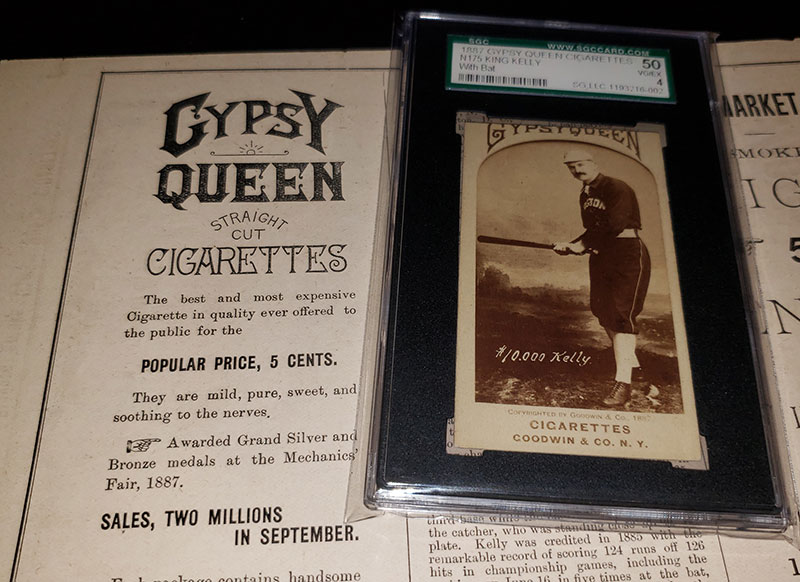
After all of my research on this barnstorming tour, the 1887 California League Score Book meant so much more to me. Little did I know there was much more to discover.
A Connection to American Literature
The San Francisco Examiner coverage of the barnstorming tour predictably afforded a lot of newspaper real estate to writing about King Kelly's arrival and performance. The coverage may sound familiar, as it reads like a preliminary draft to a famous piece of American literature that stands shoulder to shoulder with the likes of 'Twas the Night Before Christmas and The Raven.
The name of the piece? Casey at the Bat.
Curiously enough, not only did the author Ernest Thayer write Casey at the Bat; he was also the one who covered the barnstorming tour in the San Francisco Examiner. Though this tour was the last baseball event he covered before moving back east, he sent in the poem to the San Francisco Examiner mere months later on June 3, 1888.
This is what the newspapers said about Kelly's first appearance in the 1887 barnstorming tour from the SF Examiner ...

Here's a modern caricature of Casey from the Mudville Nine.
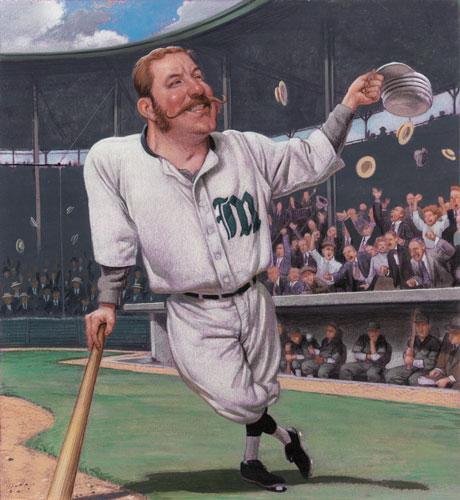
Readers of Casey at the Bat will find the larger than life showmanship of Casey quite interesting - especially in a crucial part of the game in the poem:
There was ease in Casey's manner as he stepped into his place;
There was pride in Casey's bearing and a smile lit Casey's face.
And when, responding to the cheers, he lightly doffed his hat,
No stranger in the crowd could doubt 'twas Casey at the bat.
Without knowing about King Kelly and his time in the barnstorming tour, the casual reader would assume this is a made up character.#@#@No batter would ever face such a crucial time in a real game with this bravado, but perhaps a showman would in an exhibition - a celebrity whose very likeness graced the cover of the score book of such a crucial game. Being hired as the main attraction for an exhibition tour would undoubtedly allow him to ham it up in a game of no real consequence, where he was there because of his showmanship. Kelly, by the way, would go on to perform numerous times on stage, singing, and acting.

The November 27th game write up curiously spends five paragraphs describing a single King Kelly strikeout in excruciating detail. From the beginning, it talks about how he was greeted with a generous outburst of applause when he assumed his graceful attitude facing the pitcher.
The write up continues by retelling the story of Kelly's at bat - Keep in mind that four strikes were necessary to strike out...
"One ball," cried Sheridan, then "One strike, two strikes, three strikes." The Beauty had not struck at the ball, and he was getting interested."
The phrase "and he was getting interested" is a curious one, as it suggests that Kelly let the other pitches go by without much so much as a desire to even try - perhaps to build up suspense for the final pitch.
Here is a beautiful illustration by Christopher Bing from his book "Casey at the Bat" - a book well worth purchasing! Here, you can see Casey not interested in the pitch.

The retelling of Kelly's epic barnstorming tour strikeout continues:
"Lorrigan stood facing Kel for the final effort. In came the sphere, the Beauty made a lunge with his bat which met nothing but air, and amidst the shouts of the crowd the "Only Mike" retired to the bench."
In spite of the Giants winning the game, the writer of the Kelly's at bat built up the suspense of the biggest name in baseball being struck out by the hometown hero in dramatic fashion.
But why would Kelly not even get interested until the last pitch? Perhaps that's why Kelly pitched a game during this series - not to win, but to entertain. His lack of seriousness in desire to win would also explain why he was reported to have joined some "new friends" in the stands for some drinks - during a game! In fact, there were also multiple reports of his drunkeness on the way to California that prohibited the Giants from playing other teams. Early on, there were reports of the the entire tour having been cancelled due to several of the players drinking.
For nearly a century and a half, people have debated as to who the real Casey was modeled after. Given its popularity, a number of baseball players attempted to take credit for being the subject of Casey, but fans during this time saw the similarities between Casey and the biggest name in the game, and assumed they were one and the same.
Author Ernest Thayer was asked a number of times over the years who the real subject was. He was oddly aloof if not misleading, and his responses would vary. Most prominently, he would say it was of nobody in particular, but rather written to memorialize a common theme throughout baseball. This response would prove to be an extremely intelligent tactic, allowing for fan's dreams to run wild, placing whomever they wanted the hubristic batsman to be in their fantasy. Not being tied to any particular player perhaps helped propel the ballad to immortality. Immersing yourself in the stories that were told of him daily in the newspapers paint a picture that many assumed back then: Casey and Kelly were one and the same.
DeWolf Hopper was a famous performer who could likely credit much of his success to performing Casey at the Bat a reported 10,000+ times. In turn, he can also probably take credit for helping popularize the poem. He was routinely met with praise for his enactment of it, for he didn't merely recite Casey at the Bat; he performed it. We are lucky to be able to listen to an authentic Hopper performance of the ballad by going to Youtube. Here he is performing it!
https://www.youtube.com/watch?v=yx_kH3ASNtw
Other Inspirations for Casey at the Bat
Thayer reportedly gave two additional differing responses for his Casey inspiration during his life. He once stated nearly half a century later that he modeled Casey not after anyone in baseball, but rather a high school bully with the name of Casey. This response satisfied very few, beyond perhaps borrowing nothing more than the name of Casey.
Another response was reported second hand, stating that Thayer told Hopper it was inspired by his best friend in college, Sam Winslow. Winslow was the captain of the baseball team while the two attended Harvard, and Thayer did take in a number of college baseball games. Still, things don't quite seem to line up - at least for Winslow to be the model for Casey. Rich Davis of CaseyAtThe.Blog wrote an article named "The Ballad of Sam Winslow" where he details his findings based upon research and even interviewing the living relatives of Sam Winslow.
Upon investigating, we find that Winslow was not best known for his hitting prowess, but rather as a star pitcher. One former newspaper editor notes that as a pitcher, Winslow loaded up the bases in the 9th inning three times, only to get the final batter out. These adrenaline packed games would surely leave a lasting impression on fans such as Thayer, which in turn, could have influenced the adrenaline found in Casey at the Bat. As Davis concludes, it is possible that Thayer may not have immortalized his best friend as the prideful batter striking out in embarrassing fashion, but rather as the hero for which the spotlight never fell upon during the ballad: The pitcher - a technique that would have been consistent with both Thayer's brand of humor and the literary training that he received at Harvard. This take is something that Winslow's family members seem to think is plausible as well.
Evidence for Kelly and the Barnstorming Tour of 1887
Thayer's biographers seemed to take the connection between Casey and Kelly quite seriously in their book "Ernest Thayer’s “Casey at the Bat”: Background and Characters of Baseball’s Most Famous Poem" (Jefferson NC.: McFarland & Co., 2012)

A month or so after Casey at the Bat was published, a "parody" named "Kelly at the Bat' was published, which traded Casey's name out for Kelly. This version of the poem was published in various newspapers across the United States, and was loved by many. The biographers in the aforementioned book suggest that had this not taken place, Casey at the Bat would have suffered the same fate as countless other newspaper ballads. For a time, many thought that Kelly at the Bat was the original, and Casey at the Bat was the parody.
The song written about King Kelly the following year "Slide, Kelly, Slide" also makes mention of Casey. You can be sure that these connections fans made between Kelly and Casey were just the tip of the iceberg. While none of this is absolute proof that Kelly and Casey are one and the same, it does provide us with perhaps what the general consensus was amongst the masses in the 19th century during the time of its release.
Thayer seemed to be overtly annoyed at people assuming Casey was modeled after Kelly, and appeared to distance himself from such a connection. This would make sense if Kelly's hubris rubbed him the wrong way, and he wanted the poem to be more universal. It probably didn't help much that Kelly performed the poem in front of people multiple times, embracing the folly of his supposed Casey caricature. Certainly Thayer didn't appreciate the parody of Kelly at the Bat being seen as the genuine article, either.

Still, there is good reason why so many assumed Kelly and Casey to be one and the same. The bravado of Casey seems to perfectly match Kelly to a tee, particularly during the 1887 California League Barnstorming Tour, and Casey's failure may have been an outlet for Thayer who perhaps didn't appreciate Kelly's antics. Kelly was quite the showman - a trait that helped propel him to celebrity status far among anyone else who picked up a baseball bat during this era, but was undoubtedly polarizing. Surely his drinking habits prohibited him from being at his best on the tour, which could make for good fodder for being the failed batsman in the poem.
The poem details an often overlooked and very unusual tidbit: After Casey fails to swing at the first pitch, and the umpire calls it a strike, the crowd calls for the umpire to be killed. When this happens, Casey saves him, by calling off the dogs. Interestingly enough, in a game where Boston lost to New York thanks to a few bad calls earlier that year, the crowd went after Umpire Jerry Sullivan, who was ultimately protected and saved by none other than King Kelly.
From the benches, black with people, there went up a muffled roar,
Like the beating of the storm-waves on a stern and distant shore;
"Kill him! Kill the umpire!" shouted someone on the stand;
And it's likely they'd have killed him had not Casey raised his hand.
To make things even more interesting, the poem seems to not only draw heavy inspiration from King Kelly, but other specifics from Thayer's time covering the barnstorming tour of 1887 with the Giants as well.#@#@The characters mentioned in the poem Cooney, Blake, and Flynn all played in the barnstorming winter tour of 1887 and all played at one point or another for Stockton - the team that the Giants pounded 26-0.
Speaking of Stockton, it was also known by another name once upon a time: Mudville! The name of the town mentioned in the poem. Even the topography described in Casey at the Bat matches the setting of the California Tour.
The end of the winter barnstorming tour was closely followed by the end of Thayer's journalistic career. He left the profession just as he had loaded up with all the fodder he needed to write his baseball ballad mere months later.
Many historians and authors of books on the subject agree, there is a ton of compelling evidence that Casey at the Bat was inspired by King Kelly and his time in the California Tour, perhaps even pinpointing it down to the very at bat on November 27, as noted in the SF Examiner. As with most literary pieces though, Casey at the Bat is likely an amalgam of Thayer's life experiences, with King Kelly in the 1887 barnstorming tour being arguably the foundation for which it was written.
Unlocking the Gypsy Queen Mystery
All of this leaves us with one last mystery: The Large Gypsy Queen card of King Kelly. Why are there only 9 cards in the set? Upon becoming a student of the 1887 barnstorming tour, all became crystal clear. The 9 players featured in the Gypsy Queen set each represented a position...like a specialty all-star team. 7 are Giants, 1 is an Indianapolis player, and of course, King Kelly. This got me to thinking ... what if these players matched the lineup in the 1887 California League Score Book?
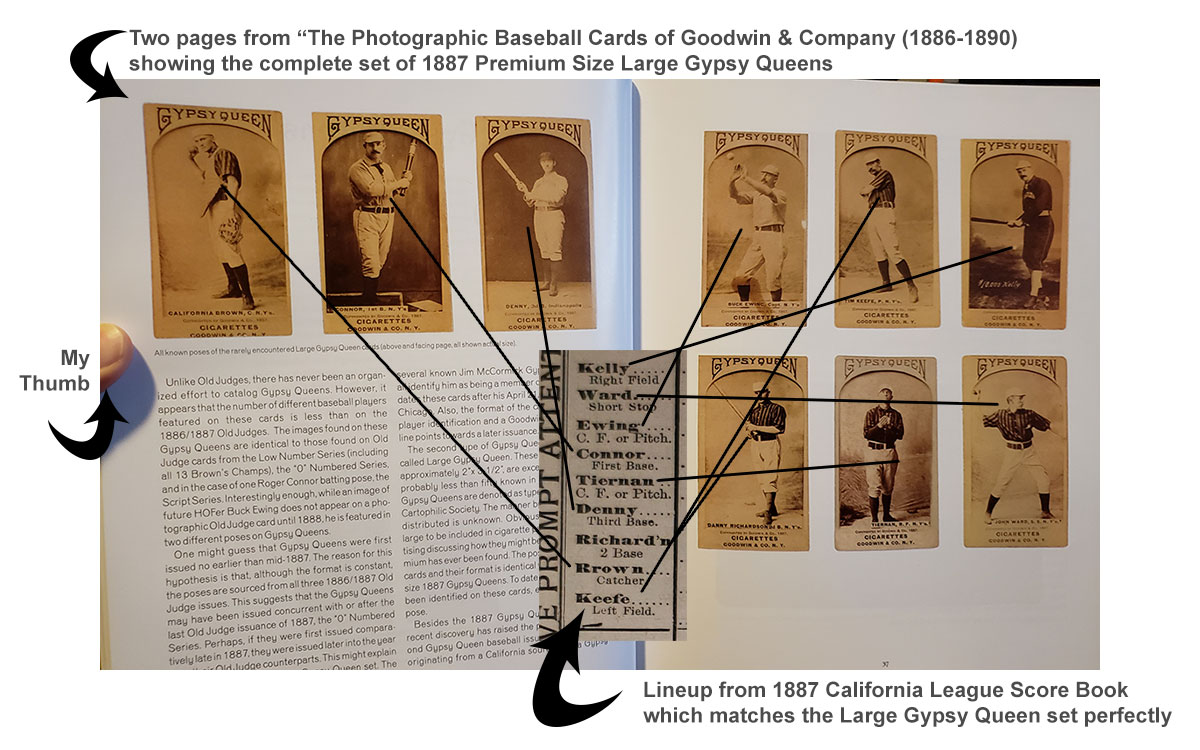
I checked, and name by name, they matched perfectly! This set appears to have been created specifically for the tour itself. Gypsy Queen was quickly becoming the most popular cigarette in the area, so it would make sense for Goodwin & Co. (the makers of Gypsy Queen) to spend their marketing dollars around such a monumental barnstorming tour by advertising in the score book, and even creating a set specifically for the tour.
The score book itself even makes mention of how photographs of the different teams were available, as well as single groups. Could this pertain to the large Gypsy Queens?
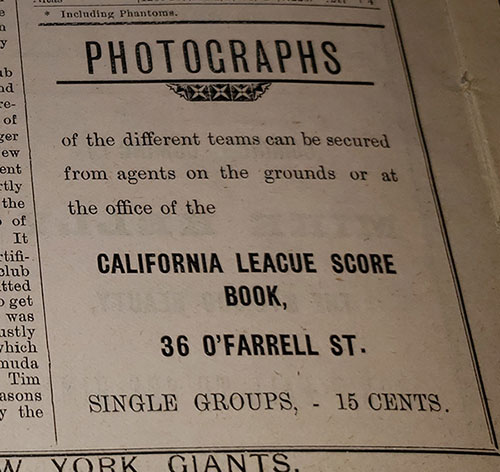
I reached out to some historians and prominent 19th century baseball card collectors about my discovery - all of this turned out to be news to them as well and they mentioned this was an incredible discovery. A regionally based offering of a score book and set of baseball cards would certainly explain their scarcity, but why are only less than 50 subjects of the set in total known to exist? Why hasn't another score book surfaced? To add more historical context, we must dig even deeper.
The San Francisco Earth Quake of 1906
"San Francisco is gone. Nothing remains of it but memories and a fringe of dwelling houses on the outskirts." - Jack London
Nearly 20 years after the tour, on April 18th at 5:12 AM, the great San Francisco earthquake of 1906 rocked the region measuring 7.9 on the Richter scale. Fires raged for several days as it devastated the area, burning up more than 80% of the entire city. There is a good chance the vast majority of all relics of the barnstorming tour of 1887 were burned up over 100 years ago.
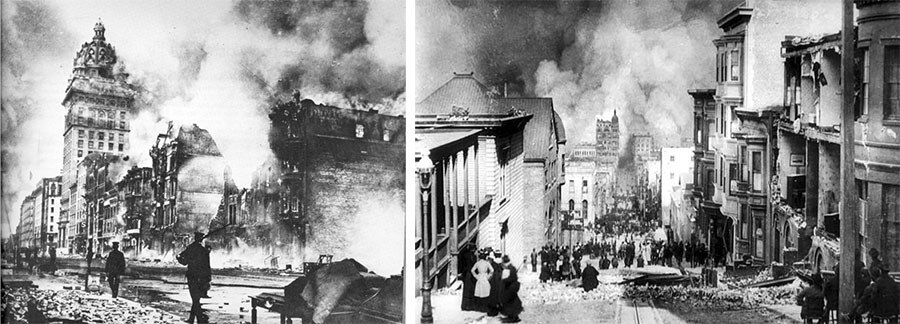 https://www.youtube.com/watch?v=mnbfDj1bL2w
Casey at the Bat Rookie Card?
https://www.youtube.com/watch?v=mnbfDj1bL2w
Casey at the Bat Rookie Card?
When I first purchased the 1887 Large Gypsy Queen King Kelly, all I knew was that I was excited for the once in a lifetime find for one of my favorite players. Little did I know that I was about to embark upon the#@baseball card version of the Da Vinci Code and Indiana Jones all wrapped up into one. Since it appears to be clear that it was created for a special set commemorating the 1887 California League barnstorming tour which could have been a key influencer for Casey at the Bat, one may consider the premium sized Gypsy Queen Kelly to also be Casey at the Bat's rookie. A relic not only of historical baseball significance, but also of historical American literature significance.
While I'm ecstatic to be the owner of what could quite possibly be considered Casey at the Bat's rookie card, I found myself more deeply in love with baseball in a time when television and radio didn't reach. As I was reading box scores and summaries of each game, I found myself audibly chuckling at Kelly's exploits - believe me, there were many of them. I got lost in the colorful commentaries, yearning to know what would happen in the next game. It all became clear to me how Americans in the 1880s were fanatical about the game that I grew up being fanatical about in the 1980s, even though they had nothing more than newspapers and baseball cards to fuel their imaginations.
Seven years after the 1887 California Tour and the Large Gypsy Queen set was produced, baseball's first superstar King Kelly passed away at the age of 36. Baseball mourned its most captivating character, and America lost one of its first celebrities. The death of the $10,000 Beauty left what seemed to be some impossibly big shoes to be filled in the game of baseball. Those shoes would be eventually filled by someone who was born 90 days after Kelly's death. His name was George, but we know him best by his nickname the Babe.
I am extremely grateful to be the caretaker of these fine pieces for the time being. If there is one thing that history has taught us, it is that they are survivors and will likely live on far longer than I will. I only hope to do an adequate job in telling their entertaining story.
At my core, I still feel like a kid who gets excited about a pack of 1989 Donruss. But then again, that's probably exactly the same feeling kids got well over a century ago when they were chasing the $10,000 beauty, King Kelly.
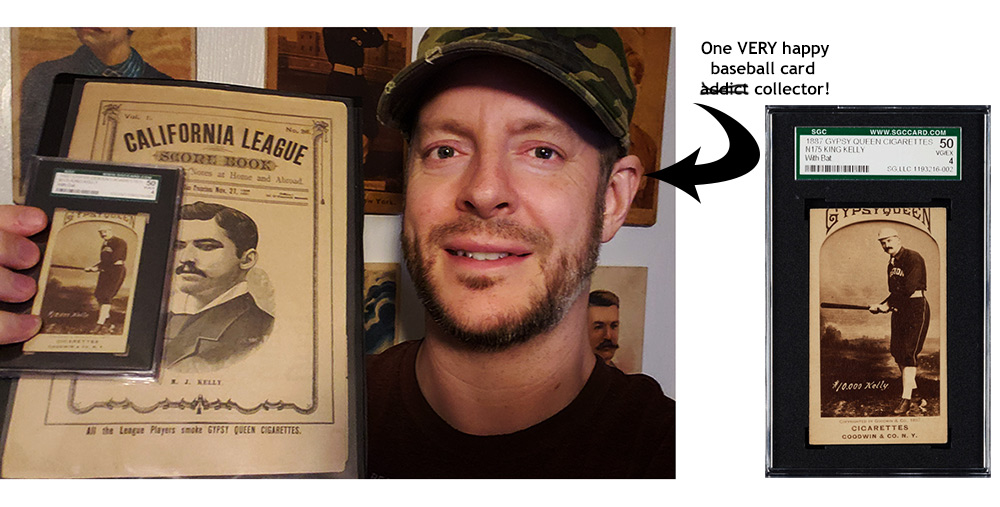 https://tanmanbaseballfan.com/2021/0...discovery.html
https://tanmanbaseballfan.com/2021/0...discovery.html